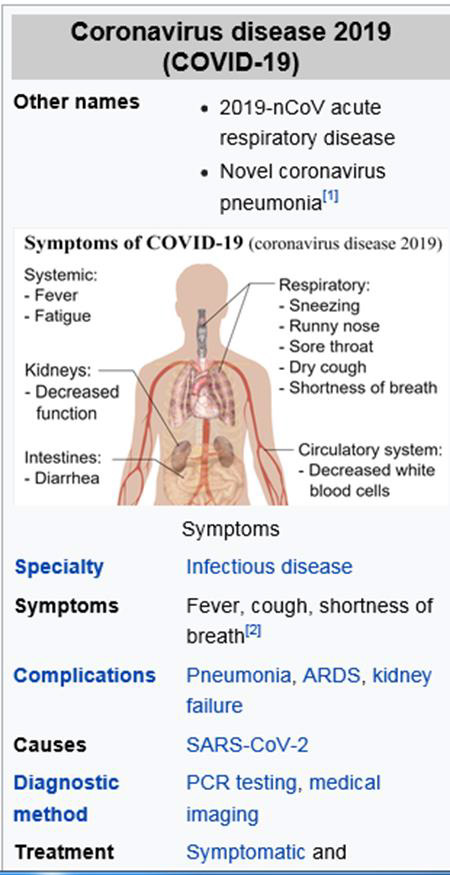


Joseph R. Anticaglia MD
Medical Advisory Board
COVID-19 (coronavirus disease 2019) was first identified in the city of Wuhan, the capital of Hubei province, China in December 2019. People over the age of 60 and those with significant medical conditions are more prone to have severe reactions. This virus is not slowing down!
As of February 27 of this year, it has invaded fifty countries and infected more than 82,000 individuals. According to a JAMA article, approximately 97% of the cases have been identified in China. Thus far, of the 2,800 deaths, about 95% have occurred in China.
It has made inroads in every continent except Antarctica. Most recently, it has spread in significant numbers to Italy, Iran and South Korea. Of particular concern, for the first time, there are more persons infected with COVID-19 on a daily basis outside of China.

In the United States, health officials bluntly signaled that the 2019 coronavirus will invade and spread throughout the country. Dr. Nancy Messonnier, director of the National Center for Immunization and Respiratory Diseases said: It’s not so much of a question of if this will happen anymore but rather more of a question of exactly when this will happen. We expect we will see community spread of the virus in the U. S.
In the first week of February of this year, Alexis visited her internist for a routine office visit. Besides getting the usual forms to fill out, she was interested in a recent questionnaire which asked her to answer the following questions:
Community spread is the transmission, in this context, of the new coronavirus to another person after answering negatively to the above first two questions. In other words, health officials have no explanation as to how a person got infected with the virus.
On February 26, 2020, the day after Dr. Messonnier announcement regarding community spread, a California woman tested positive for the coronavirus who did not travel to China and denied knowingly having contact with a person who travelled to China. She was admitted to the University of California, Davis in respiratory distress. The implications of such community spread are troublesome to health officials in the U. S and globally. Other countries have reported community transmission of COVID-19.

A large Chinese study reported that 81% of persons with the disease had mild symptoms similar to the common cold or mild cases of the flu. Another group of patients, about 14% of them, had severe symptoms of shortness of breath in addition to coughing and sneezing. Image studies showed findings consistent with pneumonia and the blood oxygen saturation was low.
The third group of patients, about 5% of them, had critical symptoms like respiratory failure requiring intubation — placing a tube in the windpipe to supply oxygen to the patient or a tracheotomy. The overall fatality of patients with confirmed COVID-19 was 2.3%.
Health care workers and health officials will be updating and incorporating their learning experiences from treating patients with SARS MERV, Ebola and the Zika virus. People should anticipate disruptions in their routine activities. For instance, Japan has closed schools for one month because of the concern about COVID-19. If you’re a single parent, how would that affect your job, your finances? Are you good at home schooling?
You may have to stock up on your medications, buy home necessities, think twice about using public transportation and shy away from public places such as cinemas, sports arenas, shopping malls, concerts, political rallies and other gatherings. Here are some things you can do to minimize contracting the new coronavirus as noted in a previous communication:
The Center for Disease Control and Prevention recommends:
Many cities and states throughout the country utilize disaster drills to deal with ‘black swans’ (unpredictable events with extreme consequences). It’s pivotal that heath officials receive adequate funding to satisfy the needs of health workers.
Workers require factual information, up to date medical education and training about this virus. They need protective gear and adequate supplies, for instance, diagnostic tool kits, surgical gloves, masks and gowns.
The public needs to be educated on how to avoid getting and spreading COVID-19. In addition, the American people want superb, health care experts in leadership positions with “combat experience” to safeguard them from COVID-19.
At the time of the publishing of the above JAMA article, there were sixty Americans who tested positive for the coronavirus disease-19; and most of them contracted it while on board the Diamond Princess Cruise ship. Inevitably, the numbers will increase.
On February 29, 2020, a man in his fifties died in King’s County, Washington due to coronavirus. His was the first death recorded in the United States because of this virus.
It’s crucial that the health care workers and the public receive truthful, useful, timely information from health officials so they can minimize the community spread of this disease. It’s a true public health emergency, not a political football. Covid-19 should not be allowed to “spin” out of control.
Nomenclature:
This article is intended solely as a learning experience. Please consult your physician for diagnostic and treatment options.